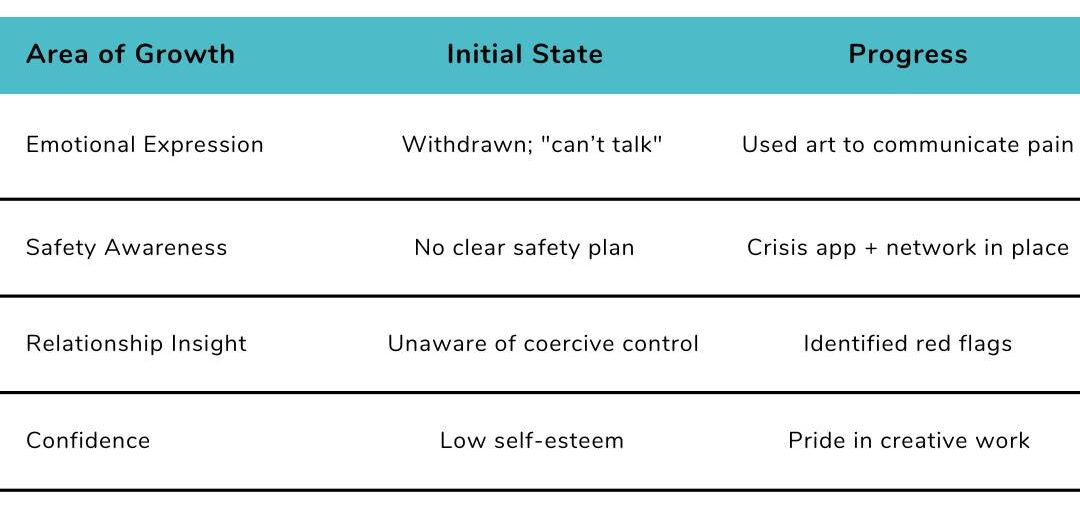How Creativity Reconnected a Withdrawn Teen to Hope and Healing
INTRODUCTION
Domestic abuse fractures a child’s sense of safety and trust, often leaving them struggling to articulate their pain. For young people like Lacey (referred to as “L”), who witness ongoing control and violence even after temporary refuge, the emotional toll can manifest as withdrawal, sadness, and a deep reluctance to share their feelings. At NIDAS, we recognise that healing requires patience, creativity, and a commitment to rebuilding trust—one step at a time.
This case study follows Lacey, a 15-year-old referred to NIDAS after her mother returned to an abusive relationship, reigniting cycles of control and conflict in the home. Through a blend of safety planning, creative expression, and gentle relationship-building, Lacey began to find her voice. Over ten sessions, she explored her emotions through art, identified red flags in relationships, and slowly rediscovered her confidence.
*Please note: names have been changed to protect client identities
 Sessions focused on:
Sessions focused on:
- Safety planning and building a support network
- Understanding healthy vs. coercive relationships
- Creative expression (art, collage, mask-making) to externalise emotions
- Building trust through alternative therapeutic settings (e.g., coffee shop visits)
- Transitioning to long-term support (Art Therapy referral)

ENGAGEMENT AND SUPPORT
 Safety as a Foundation
Safety as a Foundation
Lacey entered sessions withdrawn and hesitant, carrying the weight of her home environment. Immediate work focused on practical safety:
- Co-creating a safety plan with trusted contacts and a crisis app on her phone.
- Normalising her reluctance to talk while emphasising, “You don’t have to share until you’re ready.”

 Breaking the Silence Through Creativity
Breaking the Silence Through Creativity
Lacey’s love for photography and art became a bridge to self-expression:
- Mask-making: She painted a smiling exterior while adorning the interior with tears—a powerful metaphor for her hidden sadness. “This is how I really feel,” she shared, marking a pivotal moment of trust.
- Collage work: Lacey assembled images and words representing her future aspirations, shifting focus from chaos to hope.
- Valentine’s rocks: Painting heart-shaped stones became a calming ritual, offering respite from her noisy, tense home.

 Education on Healthy Relationships
Education on Healthy Relationships
A short film on coercive control opened discussions about red flags. Sessions gently connected her father’s behaviour to broader patterns of abuse, fostering critical awareness.
 Building Trust Beyond the Therapy Room
Building Trust Beyond the Therapy Room
To deepen engagement, sessions moved to a local coffee shop. The change of setting helped Lacey associate support with warmth and normality, not just crisis.
 Support for the Family
Support for the Family
While Lacey’s sessions were individual, NIDAS maintained contact with social services, ensuring her Child in Need plan aligned with her therapeutic goals. Mum was encouraged (via social workers) to reinforce Lacey’s safety network, though her own journey with the abusive partner remained complex.
OUTCOMES
By the final session, Lacey showed measurable progress:

NEXT STEPS
Lacey’s transition to Art Therapy will provide deeper trauma work, building on the foundation of trust and creativity established at NIDAS.
NEED TO MAKE A REFERRAL?
You can request a referral form by contacting us directly by calling at 01623 683 250 or emailing at [email protected])
Telephone: 01623 683 250
(Monday – Thursday 9:00am – 5:00pm and Friday 9:00am – 4:30pm)